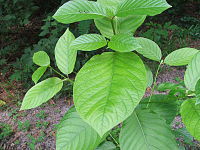
Photo from wikipedia
The monoterpene indole alkaloid (MIA) mitragynine has garnered attention as a potential treatment for pain, opioid use disorder, and opioid withdrawal because of its combined pharmacology at opioid and adrenergic… Click to show full abstract
The monoterpene indole alkaloid (MIA) mitragynine has garnered attention as a potential treatment for pain, opioid use disorder, and opioid withdrawal because of its combined pharmacology at opioid and adrenergic receptors in humans. This alkaloid is unique to Mitragyna speciosa (kratom), which accumulates over 50 MIAs and oxindole alkaloids in its leaves. Quantification of 10 targeted alkaloids from several tissue types and cultivars of M. speciosa revealed that mitragynine accumulation was highest in leaves, followed by stipules and stems, but was absent, along with other alkaloids, in roots. While mitragynine is the predominant alkaloid in mature leaves, juvenile leaves accumulate higher amounts of corynantheidine and speciociliatine. Interestingly, corynantheidine has an inverse relationship with mitragynine accumulation throughout leaf development. Characterization of various cultivars of M. speciosa indicated altered alkaloidal profiles ranging from undetectable to high levels of mitragynine. DNA barcoding and phylogenetic analysis using ribosomal ITS sequences revealed polymorphisms leading M. speciosa cultivars having lower mitragynine content to group with other mitragyna species, suggesting interspecific hybridization events. Root transcriptome analysis of low- and high-mitragynine-producing cultivars indicated significant differences in gene expression and revealed allelic variation, further supporting that hybridization events may have impacted the alkaloid profile of M. speciosa.
Journal Title: Journal of natural products
Year Published: 2023
Link to full text (if available)
Share on Social Media: Sign Up to like & get
recommendations!